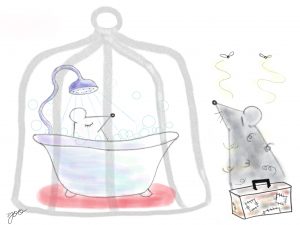‘Dirty’ mice lead USC researchers to possible culprit in autoimmune disease
Mice from pet stores co-housed with lab mice for two weeks helped scientists understand the role of a protein that modulates the inflammation response.
Contact: Leigh Hopper (310) 308-0405 or lhopper@usc.edu
When is a dirty mouse a good mouse?
USC researchers can answer that question: They introduced squeaky-clean lab mice to rodents from the outside world — mice from a pet store — and gained a clue about autoimmune disease in the process.
“Lab mice are wonderful for many kinds of experiments, but wild mice have more in common with people in terms of the germs we’re exposed to,” said first author Youn Jung Choi, a postdoctoral scholar in molecular microbiology and immunology at the Keck School of Medicine of USC . “More and more scientists who study the immune system are using pet-store mice, or mice captured from barns or other places.”
Immunity on overdrive
In Nature Immunology on Jan. 28, researchers describe how they used pet-store mice to examine the role that a particular protein plays in inflammation, a process in which the body unleashes a flood of white blood cells, hormones and chemicals to repair damaged tissue and defend against invading germs.
When inflammation goes awry, the body can go into overkill and a surplus of white blood cells may attack the body itself, resulting in autoimmune diseases like rheumatoid arthritis.
Initially, the researchers engineered lab mice to be missing a protein called SERPINB1 that helps regulate inflammation. Without it, researchers hypothesized, the lab mice would have heightened, unregulated immune responses.
But when the deficient lab mice met the normal lab mice, the results were underwhelming. Lab mice are artificially hygienic, live in a pathogen-free environment, and eat sterile food. In other words, they carry very few germs for the SERPINB1-deficient mice to react to.
A visit from the real world
That’s where the pink-eyed pet store mice come in.
The researchers housed lab mice with pet store mice — known as “dirty mice” in lab lingo — for two weeks, where they shared bedding, water and food. However, it was critical to keep the critters from contaminating lab mice not involved in this study.
Sure enough, when introduced to their germy, real-world counterparts, the lab mice mounted higher inflammation responses. The lab mice engineered to be missing the SERPINB1 protein expressed four times more inflammatory genes than the normal, SERPINB1-expressing lab mice. That leads researchers to believe that a mutation in SERPINB1 may be why the immune system goes haywire in some people.
“The immune system of a lab mouse is somewhat similar to that of a newborn human – it hasn’t been exposed to many germs,” said senior author Jae Jung, the Fletcher Jones Foundation Chair in Molecular Microbiology and Immunology at Keck. “The immune system of a pet-store mouse, or a lab mouse co-housed with a pet-store mouse, is more like what we see in an adult human. Dirty mice studies of inflammation may translate better to human disease conditions.”
Future research could include searching for genetic mutations of SERPINB1 that may play a role in autoimmune diseases and inflammatory disorders. Jung is hoping to add to his lab a specially-designated space for dirty-mice experiments.
###
In addition to Choi and Jung, authors of the study are Stephanie Kim, Younho Choi, Travis B. Nielsen, Jun Yan and Brad Spellberg of the Keck School of Medicine; Alvin Lu, Jianbin Ruan and Hao Wu of Harvard Medical School; and Hye-Ra Lee of Korea University.
The National Institutes of Health supported this work with grants CA180779, CA200422, AI073099, AI116585, AI129496, AI140705, DE023926, DE027888 and DE028521, NRF-2016R1D1A1B03931761, Al124491 and HD087988, and AI081719, AI117211, AI127954 and AI106375.
Illustration credit: Ji-Seung Yoo, Jae Jung Lab.

